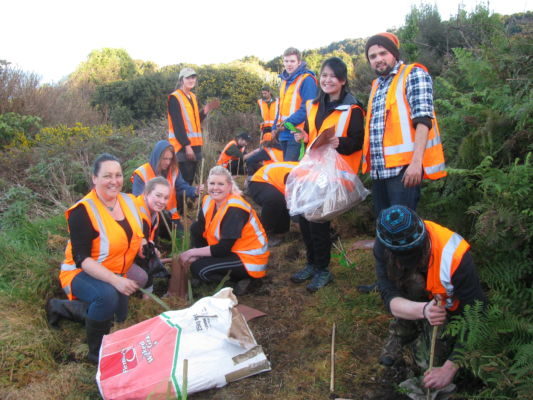To achieve a predator free New Zealand by 2050 – or by any date – the majority of New Zealand will need to back that goal. Young people in particular need to want it to happen and be engaged in making it happen. After all, it’s their future, 30 years from now, that we’re talking about.

Last year, Lucy Dickie from the University of Otago, completed a Masters Thesis looking at the extent to which young people are engaged with the Predator Free 2050 goal. Earlier this week, a specially convened Bioethics Panel released its report (PDF, 6MB) on the social, cultural and ethical challenge of achieving a predator free New Zealand.
Two reports – one from our current generation of young adults and one from a diverse panel of academic, industry and community experts – what do they have to say about achieving a predator free future?
Firstly, what are young adults’ perception of introduced mammals and their threats to the environment?
“The attitudes, involvement and knowledge of 18 to 24-year-olds towards PF2050 and predator control were surveyed in 2017. The results showed that this demographic believes small, introduced mammals (including domestic cats) to be threats to the environment, whereas larger introduced mammals are considered resources and should be managed as such.”
How to best manage and eliminate predators is both a practical and ethical question and was addressed in both reports.
The Bioethics Panel outlined some of the issues:
“Many parties are developing novel tools and technologies that could contribute to the vision of PFNZ by supporting cost-effective, landscape-scale predator control, or eradication and surveillance of small mammal pests. However, it is unclear whether New Zealanders at large share the vision of PFNZ as a whole. PFNZ presents opportunities for reasonable ethical disagreement on many levels, from the goals and objectives of PFNZ, to which tools and technologies ought to be designed and how they should be implemented. A candid and thorough exploration of these potential disagreements is vital.”
A key concern likely to spark differing points of view is the question of animal welfare and animal ethics.
“Broadly speaking, environmental ethics calls on us to protect Aotearoa New Zealand’s biological heritage. The New Zealand Animal Welfare Act (1999) allows for this within certain ‘humane treatment’ restrictions. Despite this, pursuing an environmentally ethical course of action can be inconsistent with at least some views in animal ethics. However, concern for the welfare of individual animals, in an animal ethics framework, can arguably be thought of as consistent with a (even higher priority) concern for native collectives in the context of controlling or eradicating invasive mammals—depending on the control or eradication method and technology in question.”
“For example, using genetic approaches to prevent animals from being born (with the goal of eliminating populations) arguably raises fewer concerns, from an animal ethics perspective, than using toxins to kill already living animals. However, the cultural considerations of such practices warrant consideration. What’s more, the welfare costs of pursuing PFNZ must still be assessed against accepted standards for any lethal control.”

So how do 18 to 24-year-olds feel about traditional methods of predator control and possible future technologies?
“Traditional forms of control such as traps and bait stations were viewed positively, in contrast to aerial drops of poison, which was viewed negatively. Respondents seemed open to the potential use of gene drive as a predator control method. Throughout the survey, concern was expressed for the welfare of the targeted animals, which may have contributed to the support for gene drive.”
To achieve a predator free New Zealand, many more New Zealanders will not only need to support predator control – they will need to be actively engaged in taking part.
“Making Aotearoa New Zealand predator free is as much a social challenge as it is a biological challenge,” according to the Bioethics Panel. “Alongside the aim of native biodiversity and ecosystem enhancement, PFNZ is also motivated by the cost-effectiveness of pest eradication versus ongoing suppression, the latter of which must be undertaken in perpetuity. To succeed, PFNZ will require a high level of social consensus over a long period. What PFNZ even means to different people, or how they might be motivated, will be critical elements of how it proceeds. The human dimensions of PFNZ thus overarch the entire project.”
Behavioural change will be necessary, according to the Bioethics Panel.
“Some New Zealanders already have a strong relationship with nature and recognise that pests are a threat to our biodiversity and they are already doing something about it. If supported, the success of PFNZ will rely, at least in part, on New Zealanders changing their behaviour, or being able to act in that align with PFNZ. This can involve direct behavioural changes (for example, changing how they compost) or indirect ones (for example, supporting the use of controversial new technologies).”
A better understanding of the issues, doesn’t necessarily translate to behaviour change, however, no matter how much people care.
“If PFNZ is to engage the nation, the simple linear assumption, that knowing about biodiversity problems elicits care for biodiversity and ultimately translates into conservation action, needs to be discarded. It has repeatedly been shown that knowledge and caring for an issue rarely translate into behaviour change, and in some cases there can be a boomerang effect (the more we know, the less we act).”
So how can behaviour change be achieved?
“Until we know whether there is broad support for PFNZ, the list of potential behaviours (direct or indirect) that New Zealanders may need to change over the course of the next decades remain unknown. As a strategic approach develops for PFNZ, identifying the full spectrum of relevant behaviours will be essential. Once these behaviours are identified, implementing a behaviour change programme for each of them might be necessary, as the barriers and benefits for each behaviour will vary. Furthermore, for some of the more extreme or complex behaviours a step-wise approach might be required. This model, based on over 30 years of research from public health, recognises that behaviour change is best implemented via small incremental changes rather than one giant leap.”
The Bioethics Panel recommends prioritising behaviours that are needed.
“To avoid overwhelming New Zealanders with multiple behaviours they need to change, prioritising the behaviours will be essential. This process quantifies behaviours based on the trade-off between the conservation impact and the likelihood of adoption. Thus, it can identify behaviours that are ‘low hanging fruits’. By focusing on these initially, public support for PFNZ can be fostered through hands-on experience of pest control, and can prepare New Zealanders for further behavioural change.”
So back to those 18 to 24-year-olds. Are they currently engaged with predator control?

“Overall, the majority of young adults were not directly engaged with predator control; however, they did express strong interest in PF2050 and conservation in general.”
It’s great that they’re interested – but as the Bioethics Panel has already pointed out, caring about an issue rarely translates to behaviour change.
“The enormous challenge PFNZ faces here should not be under-estimated,” state the Bioethics Panel, “A great many New Zealanders may need to change their behaviour. However, existing behaviour science research and best practice provides lessons to identify the essential elements of early engagement with New Zealanders and co-development of a way forward.”
Engagement – that is, active engagement – will be the key.
Only the abstract of Lucy Dickie’s thesis is available online, but the full thesis may be available through interloan from the University of Otago.
To what extent are young people engaged with the Predator Free 2050 goal?(2018) (Thesis, Master of Science Communication). University of Otago
The Bioethics Panels report can be read in full on the website ‘New Zealand’s Biological Heritage’:

